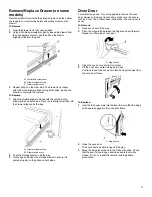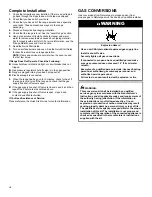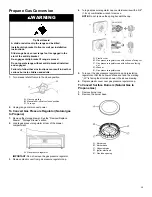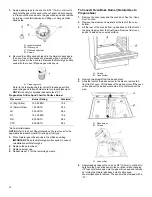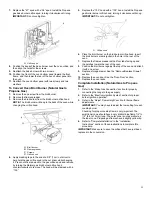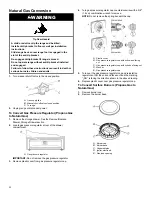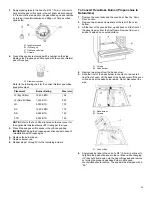
8
2.
Pour 1
3
/
4
cups (14 oz [414 mL]) of distilled or filtered water
onto the bottom of the empty oven, and close the oven door.
IMPORTANT:
Do not use chemicals or other additives with the
water. Do not open the oven door during the Clean cycle. The
water on the oven bottom is hot.
3.
Press CLEAN/AQUALIFT SELF CLEAN and then START on
the oven control panel.
4.
Allow 40 minutes for cleaning and cooldown. A beep will
sound when the Clean cycle is complete.
5.
Press OFF/CANCEL/CANCEL UPPER at the end of the cycle.
OFF/CANCEL/CANCEL UPPER may be pressed at any time
to stop the Clean cycle.
6.
Remove the residual water and loosened soils with a sponge
or cloth immediately after the Clean cycle is complete. Much
of the initial 1
3
/
4
cups (14 oz [414 mL]) of water will remain in
the oven after the cycle is completed. If additional soils
remain, leave a small amount of water in the oven bottom to
assist with the cleaning.
7.
If any soils remain, remove them with a nonscratch scrubbing
sponge or plastic scraper. Additional Clean cycles may be run
to help remove the stubborn soils.
IMPORTANT:
Do not use oven cleaners. The use of
chemicals, including commercial oven cleaners or metal
scouring pads, may cause permanent damage to the
porcelain surface of the oven interior.
NOTE:
�
The range should be level to ensure that the entire surface
of the bottom of the oven cavity is covered by water at the
beginning of the Clean cycle.
�
For best results, use distilled or filtered water. Tap water
may leave mineral deposits on the oven bottom.
�
Before removing the residual water and loosened soils at
the end of the Clean cycle, insert a cloth or paper towel
between the lower edge of the oven door and the front
frame to keep water from spilling onto the front of the
range and the floor.
�
Soil baked on through several cooking cycles will be more
difficult to remove with the Clean cycle.
�
Nonabrasive scrub sponges or eraser-style cleaning pads
(without cleaners) can be effective for cleaning the oven
cavity walls, oven door, and oven bottom for difficult soils.
For best results, moisten the pads and sponges before
use.
�
Run an additional Clean cycle for stubborn soils.
�
Affresh
®
Kitchen Appliance Cleaner and affresh
®
Cooktop
Cleaner may be used to clean the oven bottom, walls, and
door when the oven has finished the cycle and returned to
room temperature. If affresh
®
Cooktop Cleaner is used, it
is recommended to wipe out the cavity with distilled water
as well. Refer to the Quick Start Guide for ordering
information.
�
Additional AquaLift
®
Technology Cleaning Kits may be
obtained by ordering Part Number W10423113RP. Refer to
the Quick Start Guide for ordering information.
INSTALLATION INSTRUCTIONS
REQUIREMENTS
Tools and Parts
Gather the required tools and parts before starting installation.
Read and follow the instructions provided with any tools listed
here.
Tools Needed
�
Tape measure
�
Flat-blade screwdriver
�
Phillips screwdriver
�
1/8" flat-blade screwdriver
�
Level
�
Hand or electric drill
�
Hammer
�
Wrench or pliers
�
Pipe wrench
�
15/16" combination wrench
�
1/4" drive ratchet
�
3/8" nut driver
�
1/8" drill bit (for wood floors)
�
Marker or pencil
�
Pipe-joint compound
resistant to Propane gas
�
Noncorrosive leak-detection
solution
�
3/16" carbide-tipped
masonry drill bit
(for concrete/ceramic floors)
(For Slide-in/Front Control
Ranges)
For Propane/Natural Gas
Conversions
�
3/8" combination wrench
�
1/2" combination wrench
�
5/8" combination wrench
�
9/32" nut driver
�
Quadrex
®
†
or Phillips
screwdriver
�
Masking tape
�
3/8" nut driver
(For Slide-in/Front Control
Ranges)
†Quadrex
®
is a registered trademark of NLW Holdings, Inc.
Summary of Contents for MGS8800PZ
Page 55: ...NOTES...
Page 56: ...NOTES...

















